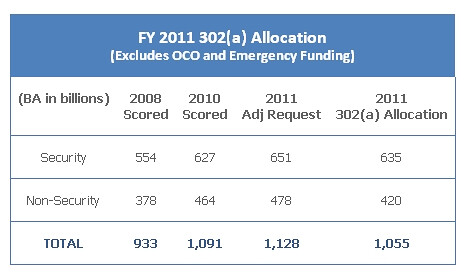House GOP Learns Cutting Spending is Hard
by Sam Rosen-Amy, 2/3/2011
 Remember back in September of last year, when the House Republicans released the “Pledge to America,” stating their agenda should they win the House in coming election? If not, here was one line which stuck out to us: “we will roll back government spending to pre-stimulus, pre-bailout levels, saving us at least $100 billion in the first year alone....” Now that they are in control of the House, Republicans are quickly working to make good on that promise. Today, House Budget Committee Chairman Paul Ryan (R-WI) released their new spending plan for fiscal year 2011, which contains cuts of... $35 billion. Looks like it isn’t quite as easy to cut spending as the new House majority thought.
Remember back in September of last year, when the House Republicans released the “Pledge to America,” stating their agenda should they win the House in coming election? If not, here was one line which stuck out to us: “we will roll back government spending to pre-stimulus, pre-bailout levels, saving us at least $100 billion in the first year alone....” Now that they are in control of the House, Republicans are quickly working to make good on that promise. Today, House Budget Committee Chairman Paul Ryan (R-WI) released their new spending plan for fiscal year 2011, which contains cuts of... $35 billion. Looks like it isn’t quite as easy to cut spending as the new House majority thought.
House Republicans have been slowly walking back their $100 billion claim almost as soon as they released it. By early January, they had already lowered that figure to between $50 and $60 billion. House leadership tried to explain away the difference by saying that, since the fiscal year is already four months old, they had to pro-rate their initial claim (remember, Congress is still working on the FY 2011 budget thanks to Republican intransigence in the lame duck). Apparently the $100 billion estimate was only for a full fiscal year.
But if you look back to the line in the Pledge, the House Republicans were clearly demanding a return to “pre-stimulus, pre-bailout levels,” i.e. FY 2008 levels. As the House Budget chart shows, they only barely got below FY 2010 levels (the $35 billion cut is relative to last year's budget). The new spending levels are still $122 billion above FY 2008.
[The "Adj Request" column is President Obama's FY 2011 request, the "302(a) Allocation" column is Ryan's FY 2011 levels. Source: House Budget Committee.]
We’re seeing the House Republicans learn one of the eternal truths in politics: it’s easier to cut taxes or increase spending than cut spending. You can always find a coalition to save some spending measure. Defense spending has its legions of contractors, Social Security has its seniors, health care has hospitals and insurers, education has legions of teachers. Try to cut spending, and you’re sure to run into groups fighting to keep the spending in the budget. It’s the same theory behind all those polls that show Americans want to cut spending, but when faced with actual cuts, strongly support pretty much everything except foreign aid. In the abstract, cutting spending is a breeze, but when you get down to the details, it’s one of the hardest things to do in Washington.
This isn’t necessarily a bad thing; for instance, right now, the nation needs more spending, not less, to help us weather the recession’s aftershocks. But it shouldn’t be surprising that the House GOP has been slowly reducing the amount of money they’re promising to cut from the budget. Ryan says it’s because we’re already four months into the fiscal year, but the truth is, a $100 billion spending cut would be almost impossible to get through Congress.
This isn’t the last word on the FY 2011 budget, however. The levels Ryan set are known as the “302(a)” allocation, which dictate the overall spending level for the House Appropriations Committee, meaning Ryan’s numbers are a long way from actual program cuts. That is left to the Appropriations Committee, which then decides how to split up the 302(a) allocation into the 302(b) allocations. These 302(b) allocations set spending levels for the various Appropriations sub-committees, and are important for the appropriations bills they are supposed to pass to fund the government.
The Appropriations Committee just released these allocations in response to Ryan’s announcement, and the cuts are pretty ugly. Double-digit percentage point cuts to the appropriation bills for transportation, housing, science, food safety, science, and the Justice Department, while the defense spending bill gets a two percent increase. So even though House Republicans are only cutting $35 billion, these cuts will be felt across the government. We’ll have more to say about this in the next week or so, but for now, let’s just hope the House Appropriations sub-committees roll back these cuts when they craft their spending bills.
Image by Flickr user SpeakerBoehner used under a Creative Commons license.




